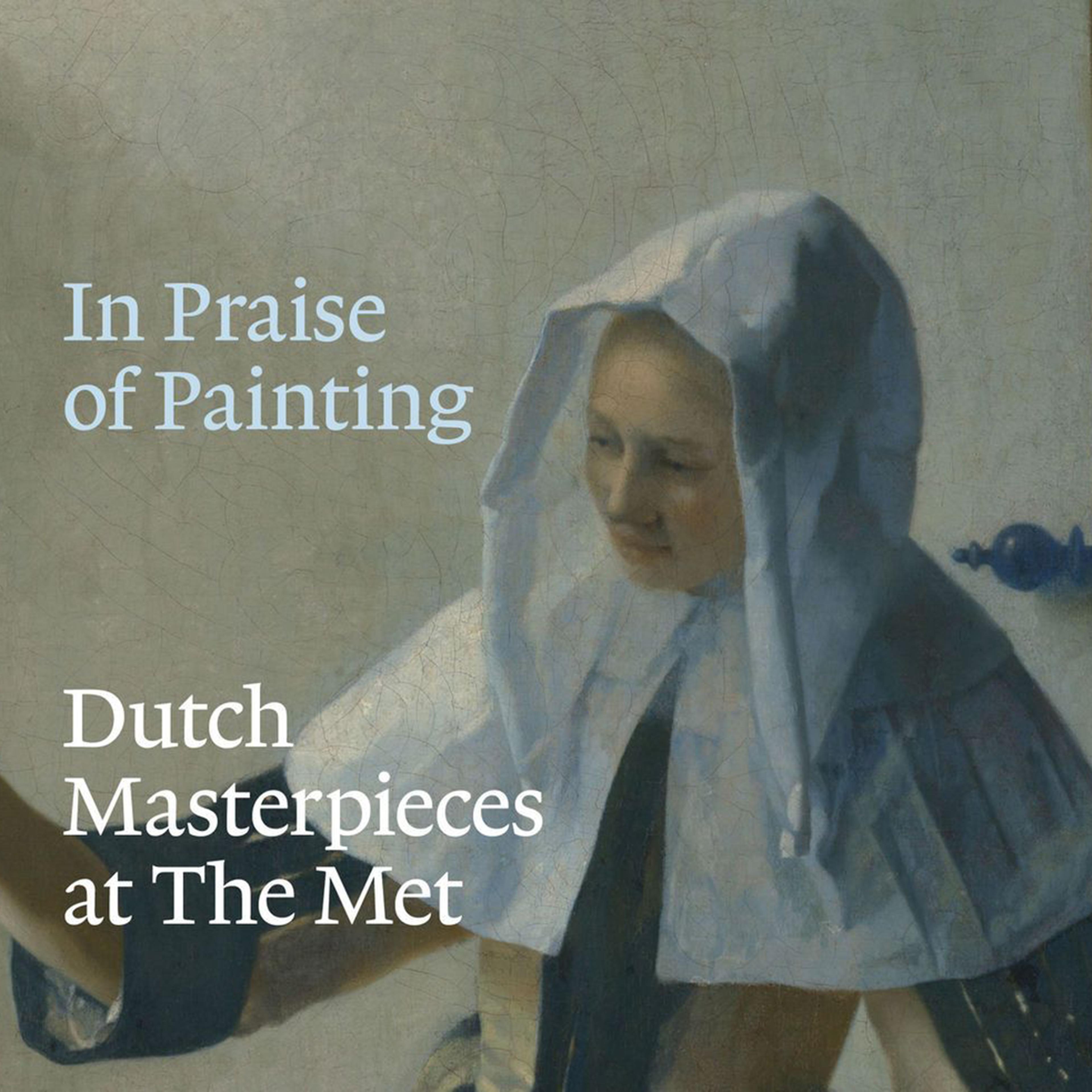Visiting Guide

Over the course of eighty years of warfare, finally concluded in 1648, the northern provinces of the Netherlands achieved independence from Spain and established the Dutch Republic. In this officially Protestant state, artists could not rely on church or court commissions; instead, they developed a recognizably modern art market that encouraged experimentation and led to the emergence of new secular kinds of painting, such as landscape and still life.
Dutch paintings were among the first works purchased by The Met after its founding in 1870. Subsequent gifts and purchases built one of the world's great collections of Dutch art, focused on three towering figures: Rembrandt van Rijn, Frans Hals, and Johannes Vermeer. There are, of course, blind spots in the story these particular acquisitions tell. Colonialism, slavery, and war—major themes in seventeenth-century Dutch history—are scarcely visible here, and only one picture painted by an early modern Dutch woman has entered the collection over the course of nearly 150 years.
This exhibition presents The Met's fabled seventeenth-century Dutch paintings in a new light. Famous works appear in dialogue with others long kept in storage, and pictures usually shown in separate parts of the Museum—including paintings from the Robert Lehman Collection—are united in a thematic arrangement that emphasizes the controversies that animated the era, whether about religion or realistic depictions of the human body. The exhibition title comes from an address the Dutch artist Philips Angel gave in 1641, in which he promoted painting's ability to imitate nature. Gathering together realist and idealist works, icons of the Museum and remarkable rediscoveries, this presentation brings back to life seventeenth-century debates about art, faith, and consumption.
Faces of a New Nation
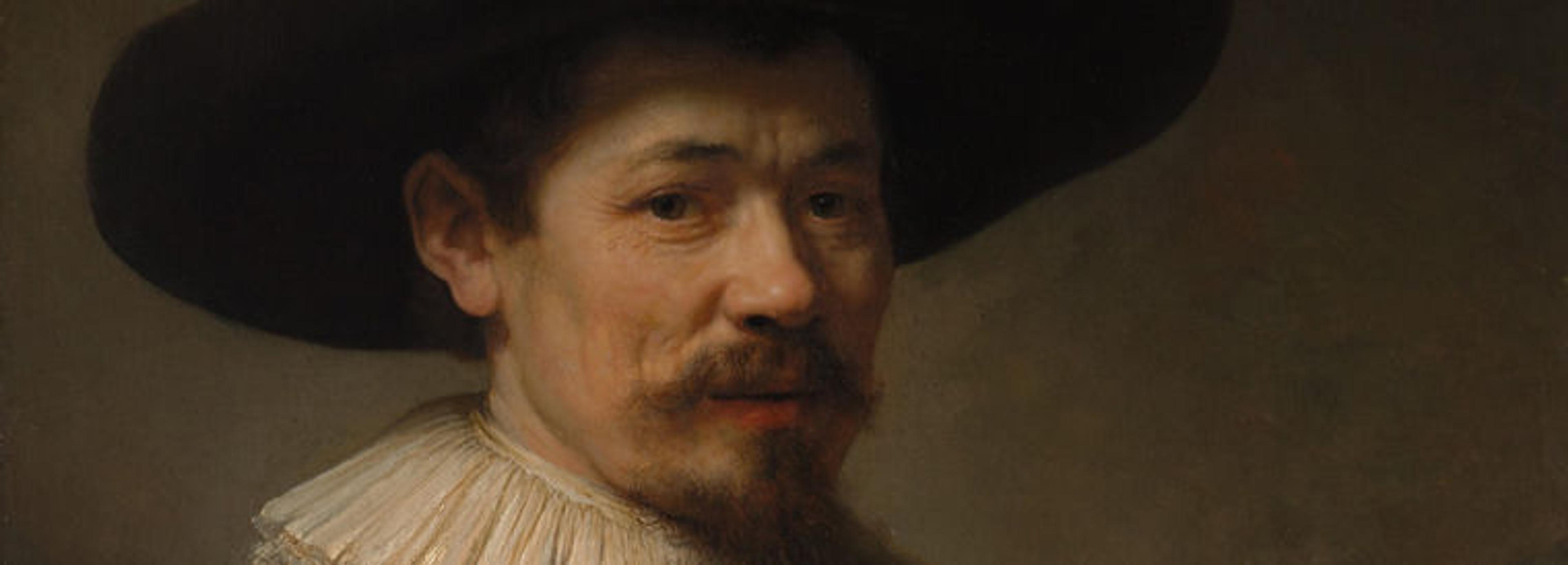

5240. Introduction; Rembrandt, Aristotle with a Bust of Homer
ADAM EAKER: Hi, my name is Adam Eaker. I’m an Assistant Curator in the Department of European Paintings here at The Met. It's an incredible privilege for me as a young curator to be able to rethink the story that the Museum tells with one of the most celebrated parts of its collection. And coming at this from a different angle, I wanted to put these pictures in a new conversation with each other and tell some aspects of the story of seventeenth-century Dutch art that may be less familiar.
NARRATOR: What is it that makes these works among the most beloved in The Met’s collection? Why do they remain so meaningful and compelling to modern viewers? On this tour, we posed these questions to experts from diverse fields; and they’ve shared stories about how these masterpieces provide unique inspiration for their own creativity.
MARK DOTY: I think it's the quality of emotion; that it's suffused with feeling.
GAVIN FINNEY: Well, cinematographers love Rembrandt because Rembrandt isn’t afraid of the dark.
DOROTHY MAHON: There is no question in my mind from having worked closely on Rembrandt that he would rank among one of the greatest painters that ever lived. There’s no doubt.
NARRATOR: Rembrandt painted this portrait of Aristotle for an Italian nobleman, dressing the Greek philosopher in a dark garment with billowing white sleeves. This may be a costume—Rembrandt was known for having fanciful exotic clothing in the studio for his models to wear.
ADAM EAKER: You have this intensely somber color palette; a really moving, intense expression on the central figure’s face. And it's a painting that really looks like what we expect a Rembrandt to look like: a somber, powerfully painted, completely absorbing work of art. And for that reason it's really become an icon of the Dutch collection at The Met.
NARRATOR: When The Metropolitan Museum of Art was founded in 1870, its collection reflected America’s broader taste for Dutch art. The great collectors of New York had ties to the original founders of the city, then called New Amsterdam.
That connection holds today, as you will hear on this tour. Exhibition curator Adam Eaker is joined by Met conservators Gerrit Albertson and Dorothy Mahon, in addition to writer Mark Doty, cinematographer Gavin Finney, and third-generation Dutch florist Remco van Vliet.
This audio tour is sponsored by Bloomberg Philanthropies.
Playlist
The Dutch Republic emerged out of a revolution against Spanish imperialism and the imposition of the Catholic faith. In the process, the once politically and culturally unified Netherlands split into two states—the independent and officially Protestant Dutch Republic, and the Spanish Netherlands, roughly corresponding to modern Belgium, which remained Catholic. Flooded with refugees from war and religious persecution, the Dutch Republic was a nation of great social mobility and diversity. Those who could afford to commission portraits used them to express their identities and status through costume, accessories, and coats of arms. Portraiture offered artists not only a ready source of income, but also the chance to experiment, devising new ways to express individuality and the ties of affection between couples and family members.
Selected Artworks
Press the down key to skip to the last item.
Questions of Faith


5241. Emanuel De Witte, Interior of the Oude Kerk, Delft
NARRATOR: At first glance, this light-filled Gothic church might seem like a perfect place for quiet contemplation. But take another look. Curator Adam Eaker.
ADAM EAKER: The seventeenth-century Dutch church was where you met up with your neighbors, transact a business deal, teenagers could flirt clandestinely. It really is the space where all aspects of everyday life might be carried out.
NARRATOR: Emanuel de Witte’s Oude Kerk, or old church, in Delft, is an exceptionally detailed rendering of the space. It makes it easy to forget that he modified key elements to create the view he wanted. For example, he omitted the pulpit.
At the center, children draw on the base of a whitewashed column. To the right, sunlight falls on a dog lifting his leg to urinate.
ADAM EAKER: This is precisely the sort of anecdotal, even crude realism that really offended idealist writers about art, that now I think fascinates viewers of this kind of painting, and makes it seem so real, so convincing to us as a document of everyday life in the seventeenth century.
One of the key things to know about this chapter of Dutch history is that it began with an act of iconoclastic violence.
NARRATOR: In 1566, a wave of attacks spread through the Netherlands. Protestants staged riots as a reaction to the imposition of Spanish rule and the Catholic Church.
ADAM EAKER: The churches are stripped, the sculptures and paintings smashed, and the walls are whitewashed in an attempt to purify them according to the dictates of the Reformation.
NARRATOR: What does remain on the columns are coats of arms marking burial sites. At the very bottom of the painting is a freshly dug tomb—meant to remind us that this life is fleeting. We can often find this combination of high and low in one painting: the sobering message alongside irreverent details.
ADAM EAKER: When you get distracted by the dog urinating, you might overlook the open grave that’s right in the foreground, and in a sense, you’re enacting the experience of a kind of moral education that this picture is supposed to provide.
Playlist
The Dutch Revolt began in 1566 with an outburst of violence that included the wholesale destruction of religious art in churches throughout the Netherlands (events known as the Iconoclasm). In the officially Protestant Dutch Republic that gained independence over the following decades, devotion focused on scripture, ostensibly without the mediation of images, and churches were whitewashed and stripped of paintings, sculpture, and stained glass. Nonetheless, a substantial portion of the population, including prominent citizens and artists such as Vermeer, remained Catholic. The paintings gathered in this section—ranging from views of the reformed interiors of Protestant churches to images of Catholic devotion, intended for the private veneration of the Virgin Mary—reflect the religious diversity of the Dutch Republic.
Selected Artworks
Press the down key to skip to the last item.
Staking a Claim
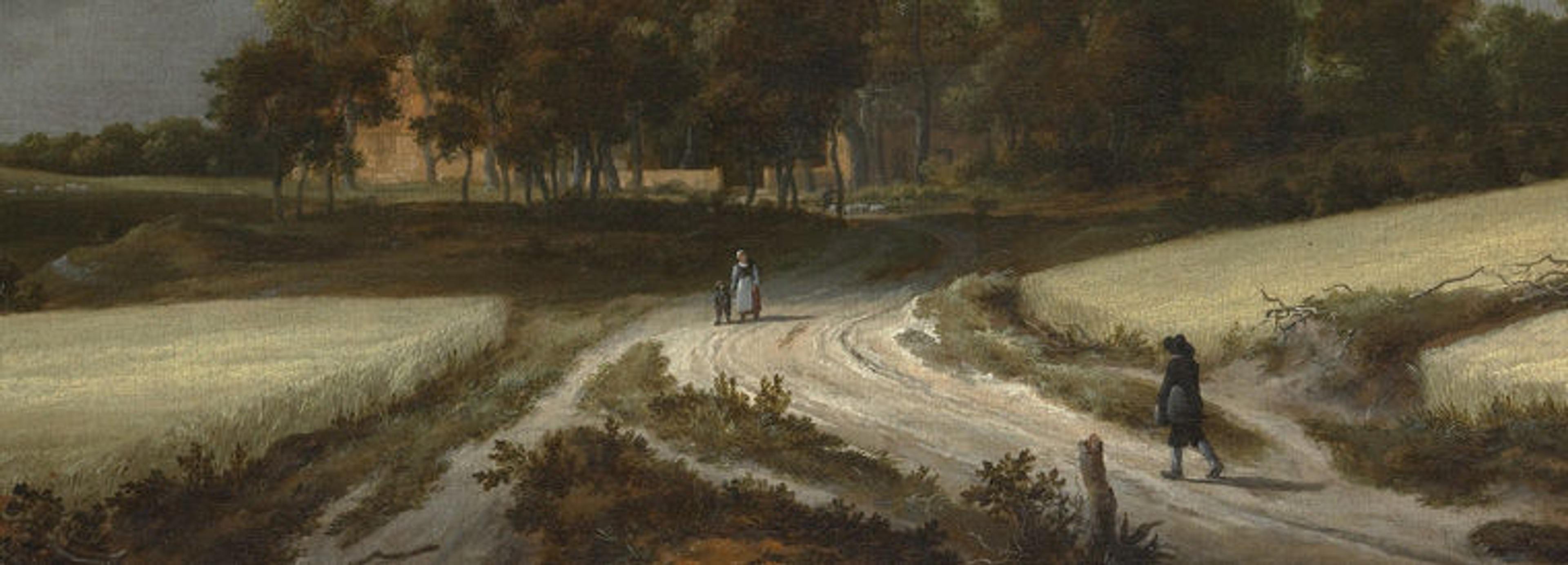

5245. Jacob van Ruisdael, Wheat Fields
NARRATOR: When he works behind the camera, cinematographer Gavin Finney tells stories by using film to capture movement. But what if you’re a seventeenth-century landscapist, Jacob van Ruisdael, and instead you have a paintbrush? Finney and curator Adam Eaker discuss.
ADAM EAKER: So he conveys the ordinariness of the Dutch landscape, and at the same time, he transfigures it through light—through the depiction of the sky—into something really dramatic and extraordinary.
GAVIN FINNEY: He’s picked the moment you’d want to press the shutter on a camera, which is this gap in the clouds illuminating the woman and the child. And they’re right on the edge of a shadow of a cloud. We know these clouds are moving. And in my mind, they’re moving towards us, and I think there’s a spotlight racing towards the viewer. And in the next second, the lady and the child will be in darkness.
NARRATOR: The painted scene, like a moving shot in a film, serves a larger story. It invites us to speculate.
GAVIN FINNEY: The man’s carrying a bag. They’re standing still, the woman and the child—so are they waiting for the man? He’s carrying a bag—has he come off a ship? Is he father, or brother, or husband? What’s the story here? It’s not just figures put in for scale; there’s a human narrative going on here as well, enveloped in this great landscape.
NARRATOR: On the far left, the landscape opens to the sea.
ADAM EAKER: I like to think that Ruisdael included this glimpse of the sea as a way of expanding the horizon—both literally and figuratively—to show a kind of interconnectedness between this humble path and some world outside the frame.
GAVIN FINNEY: When you stand in front of it, you can almost imagine it coming to life.
Playlist
The flat terrain of the Netherlands provided the unlikely inspiration for the birth of independent landscape painting in Europe, where it had previously functioned as a setting for religious or historical storytelling. Seventeenth-century Dutch painters embraced the broad vistas and dramatic skies of their home turf, transforming ordinary fields and harbors into meditations on the relationship between people and their environment. Other artists traveled abroad or used their imaginations to conjure more exotic landscapes that appealed to a nation of traders and colonizers. As the mercantile class increasingly adopted the trappings of the aristocracy, they decorated their estates with images that expressed an ideal of land ownership and rural abundance.
Selected Artworks
Press the down key to skip to the last item.
Masters, Pupils, Rivals
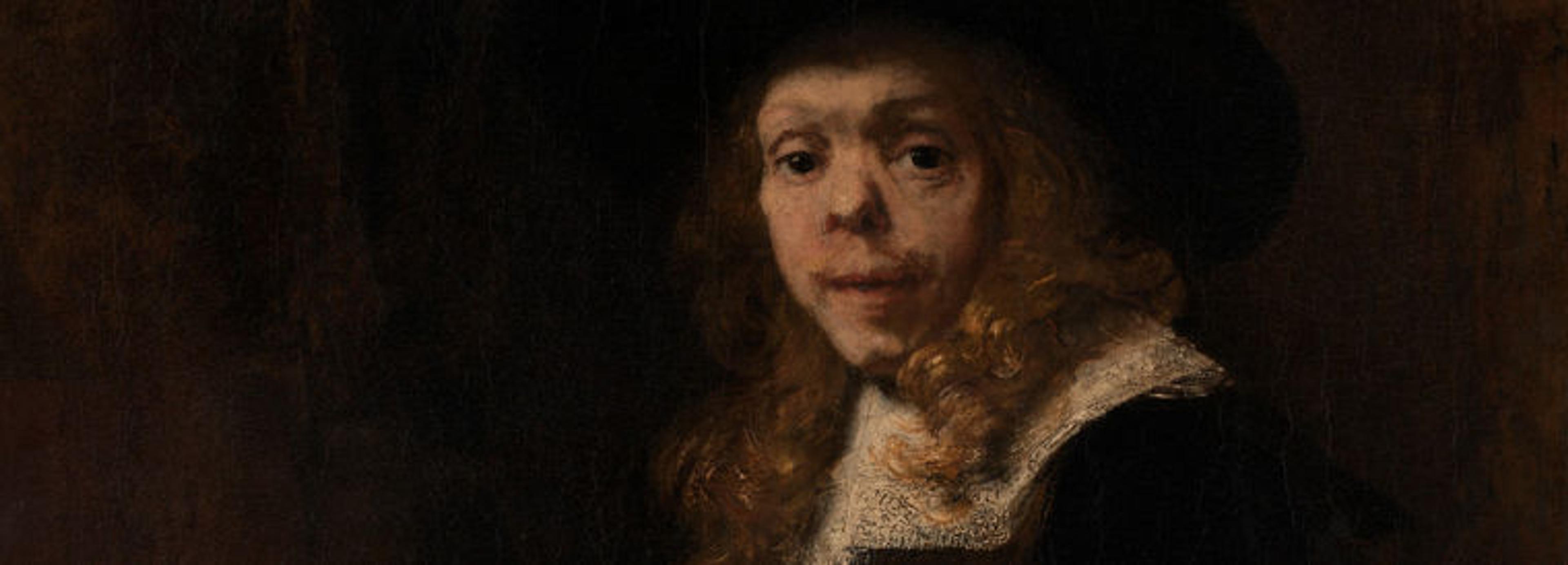

5249. Rembrandt, Self-Portrait
NARRATOR: In 2018, the Museum removed this Rembrandt self-portrait from view while the gallery in which it normally hangs was renovated. It turned into an opportunity for Dorothy Mahon, who jumped at the chance to conserve it. She’s been a conservator at The Met for more than thirty years.
DOROTHY MAHON: This portrait, that is so important to our collection, and so popular, it just wasn’t looking as grand as it should. It just is very difficult to get a painting off the wall, especially one that people want to have up all the time.
NARRATOR: For the first step of the conservation process, Mahon removed layers of a synthetic varnish that had been applied in the 1950s. Originally intended to protect the painting, it had not aged well—it dulled and obscured the painting’s surface. As the layers came off, the subtlety of Rembrandt’s colors and technique reappeared.
DOROTHY MAHON: He’s essentially painted this picture with white and black, some earth colors, red and browns, some yellow ochre. That’s it. The other thing that’s really important to see as a characteristic aspect of Rembrandt is the actual texture of the brushstrokes. The individual brushstrokes are set one next to the other. In the cool bluish tints you see the translucency of the flesh. And the way he describes the fall of light.
NARRATOR: Rembrandt also left behind clues to his working process. Look just above his hat, on the left, to see how he re-shaped its contours repeatedly. You can also see how he used the end of the paintbrush to etch out the mass of curls tucked under his hat.
Mahon insists conserving a Rembrandt is not terrifying…at all. She relies on her extensive training and decades of experience, yet always comes away with a deeper understanding of the artist, even one as legendary as Rembrandt.
DOROTHY MAHON: He’s almost a cliché, but there’s a reason sometimes why artists become a cliché. He knows exactly what he wants to achieve. He was very ambitious, he had the natural talent. And when you get close to a Rembrandt, as my privilege is to do, one can see the way he handles the paint and the way he does his depictions. He absolutely ranks among the greatest painters who ever lived.
Playlist
I do not want to deny that I once had a special preference for [Rembrandt's] manner; but at that time I had hardly begun to understand the infallible rules of art. I found it necessary to recant my error and to repudiate his.
—Gerard de Lairesse, 1707
No figure has dominated the story of seventeenth-century Dutch painting like Rembrandt van Rijn. Celebrated from an early age, he established a large studio in Amsterdam with many pupils who emulated his manner. A number of these students, such as Gerrit Dou and Nicolaes Maes, eventually succeeded in creating independent styles and successful careers of their own. As Rembrandt aged, his art fell out of fashion, and he became the target of idealist critics, including some of his former followers and admirers. Although he died in poverty, Rembrandt's work was rediscovered by eighteenth-century collectors and has remained coveted ever since.
Selected Artworks
Press the down key to skip to the last item.
Comic Painting
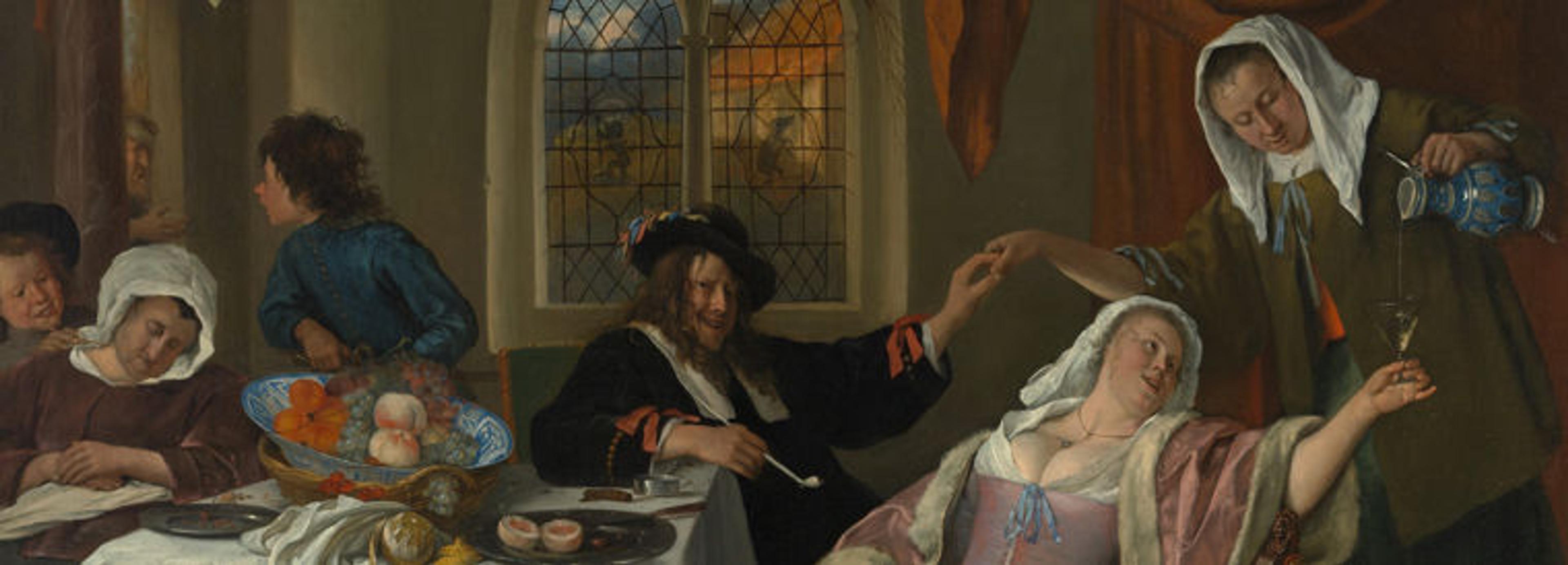

5247. Jan Steen, The Dissolute Household
ADAM EAKER: This painting gives us a whole catalog of different transgressions.
NARRATOR: Sloth, lust, gluttony, sacrilege, gambling, vanity, and poor parenting—all are on full display in Jan Steen’s Dissolute Household.
ADAM EAKER: Whether it’s overindulgence in food and alcohol and tobacco; whether it’s the licentiousness of the husband’s flirtation with the maid; the way that the children are allowed to run wild. Even the unsupervised cat suggests that the patriarch of the family is not doing his job in imposing an atmosphere of discipline.
NARRATOR: Seated in the middle of it all is the artist himself. His sly smirk suggests he is in on the joke. At right, Steen’s wife may have served as the model for the reclining woman reaching for another drink; on the left, his own sons for the unruly boys tormenting a sleeping woman.
Throughout the raucous scene are smaller, still-life arrangements. The table features a blue and white porcelain bowl filled with fruit; a peeled lemon; a halved peach; and tobacco, a relatively recent import from the New World—and one frowned upon by Calvinist preachers. Overhead is a more grave, symbolic warning.
ADAM EAKER: This still-life in a basket that hangs suspended over the family contains plague rattles, clappers that a leper would use to announce his or her presence, sticks that might be used to deliver a beating. All sorts of intimations of the kind of dire fate that can await people who engage in this sort of excess.
NARRATOR: Most of all? We witness what may be the supreme sin in Dutch culture: a disorderly household.
ADAM EAKER: Even to this day, Dutch parents who want their children to clean up their rooms can tell them that their rooms are starting to look like a household by Jan Steen. It’s something that every Dutch person immediately will recognize.
Playlist
We hardly see a beautiful hall or fine apartment of any cost that is not decorated with pictures of beggars, bordellos, taverns, tobacco smokers, musicians, dirty children on their pots, and other things more filthy and worse.
—Gerard de Lairesse, 1707
Although the paintings in this section were expensive commodities destined for discerning patrons, their subject matter is down-to-earth and, in some cases, lewd. In the first half of the seventeenth century especially, Dutch collectors reveled in scenes of carousing and misbehavior, particularly among the lower classes. Scholars debate the degree to which such paintings reinforced a sense of moral and social superiority in the viewer or simply provided a good laugh. As the Dutch elite adopted more of the tastes and behaviors of French aristocratic culture later in the century, this coarse and comic subject matter began to fall out of fashion.
Selected Artworks
Press the down key to skip to the last item.
Contested Bodies
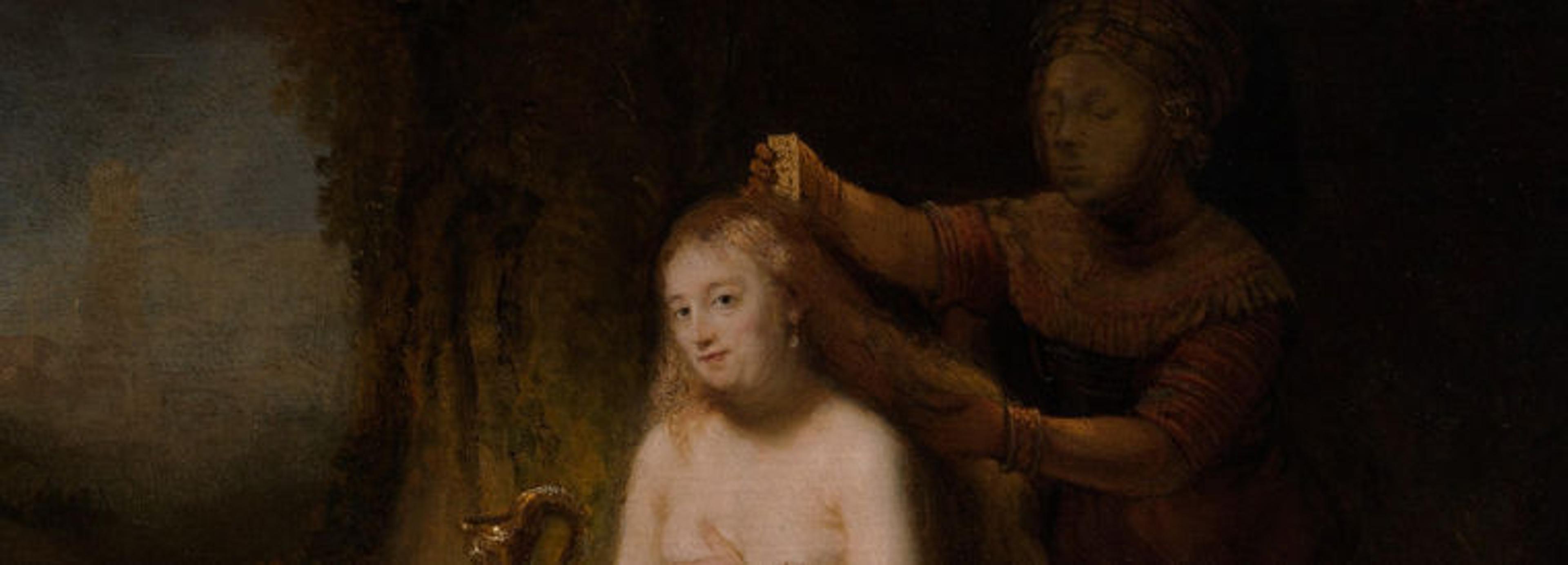

5251. Gerard de Lairesse, Apollo and Aurora
NARRATOR: This interpretation of the myth of the sun god Apollo and the goddess of the dawn Aurora might seem a startling addition to a group of Dutch masterpiece paintings. Consider it in relation to the work directly across this courtyard: Rembrandt’s portrait of Aristotle. Adam Eaker.
ADAM EAKER: On the one hand, you have Rembrandt’s Aristotle Contemplating the Bust of Homer, one of the most canonical and iconic of Dutch paintings in The Met’s collection. And on the other you have this work, Gerard de Lairesse’s Apollo and Aurora, something that normally hangs in our storage.
NARRATOR: Eaker took it out of storage to remind us that Rembrandt was not always the beloved icon he is today.
ADAM EAKER: Visitors may be surprised to learn that de Lairesse was an extremely celebrated figure in his own day, very successful, who really catered to the idealist, classicizing taste that rejected Rembrandt. We see here a very luminous image of two beautiful young deities. It’s an image that reveals de Lairesse’s knowledge of classical antiquity, of Italian painting.
NARRATOR: The subject is taken straight from mythology, but the couple’s faces are individual enough to suggest they were modeled on real people. This may have been commissioned as a wedding portrait of a young couple.
Over the centuries, de Lairesse’s style eventually fell out of favor. His idealism departed from the naturalism prevalent in Dutch art.
ADAM EAKER: Nowadays, we celebrate those Dutch artists who seem to us uniquely Dutch; very local and rooted in their own circumstances. And in that perspective, de Lairesse can seem kind of bland, kind of generic, because he so successfully emulated international currents instead of depicting those uniquely Dutch subject matters or landscapes.
Playlist
[Rembrandt] chose no Greek Venus as his model / But rather a washerwoman or a treader of peat from a barn / And called this whim "imitation of nature."
—Andries Pels, 1681
History painting, depicting episodes from classical myth and the Bible, was the most prestigious category of art by seventeenth-century standards. It required artists to master the depiction of the human form, considered to be the basic building block of visual storytelling. Nonetheless, Dutch painters took divergent approaches to depicting the body. Some assimilated their figures to a classical ideal, based more on ancient sculpture than on close observation of live models. Others, most notoriously Rembrandt, populated their history paintings with ordinary-looking people who seemed to have stepped right off the street and into the artist's studio.
Selected Artworks
Press the down key to skip to the last item.
Eloquent Things

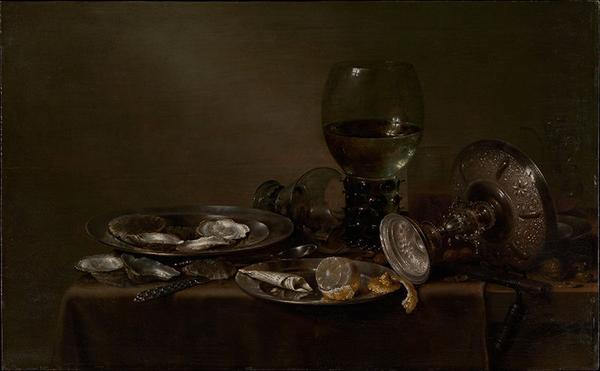
5253. Willem Claesz Heda, Still Life with Oysters, a Silver Tazza, and Glassware
MARK DOTY: One of the reasons that paintings are so moving to us is that we see things that we know. And these things are sort of miraculously turned into two-dimensional representations on the canvas.
NARRATOR: Most strikingly, this painting demonstrates the artist’s remarkable skill at rendering different surface details. But beyond this, the painting presents other elements ripe for interpretation. Who was enjoying these oysters? Why did they leave so suddenly?
MARK DOTY: My name is Mark Doty. I am a poet and memoirist, essayist. As a writer, I respond so immediately to visual images. And it’s partly because you can do so swiftly in paint what would take you forever to try to do in words.
NARRATOR: Some of the objects appear familiar to us today, others less so. A page from an almanac is twisted into a cone to hold spices. A silver tazza, or shallow cup, is toppled. The tension between the appetizing lusciousness of the elements on the table and the sense of disarray makes us curious about the hidden story or context.
MARK DOTY: The eye’s going voyaging here, to see what can be discovered by testing yourself against things. And he’s also really showing his almost ridiculous capacity for evoking detail. You look at the chasing and engraving on that silver cup; it’s just such an act of accomplishment.
NARRATOR: The cup is overturned. One glass is broken. To Doty, the scene feels slightly ominous.
MARK DOTY: I don’t think this would be an easy painting to live with. That may be a compliment to it; it effectively gets a little bit under your skin, and you don’t know at first that that’s going to happen. It doesn’t look like it’s going to be disturbing, but the more I spend time with it, the more, there’s something uncomfortable, perhaps, about the relationship between the richness of these items and their disarray.
NARRATOR: This intimate, somewhat mysterious scene, leads us to question what our objects may reveal about us.
MARK DOTY: What would you put in your still life? What would you choose from your own house to represent?
Playlist
Like landscape painting, still life was a new and experimental genre that reached great heights in seventeenth-century Dutch painting. Artists used still life to convey a variety of messages about human vanity or the pleasures of conspicuous consumption and imported luxuries. The depiction of foods and objects, even the most humble, provided artists the opportunity to display their illusionistic skills. Some still life painters worked in close dialogue with scientists as they applied a new rigor to observation of the natural world. As images of things without people, still life paintings pictured the bounty provided by newly established Dutch trade routes and the Republic's economic success, while omitting the human cost of colonial warfare and slavery.
Selected Artworks
Press the down key to skip to the last item.
Lives of Women
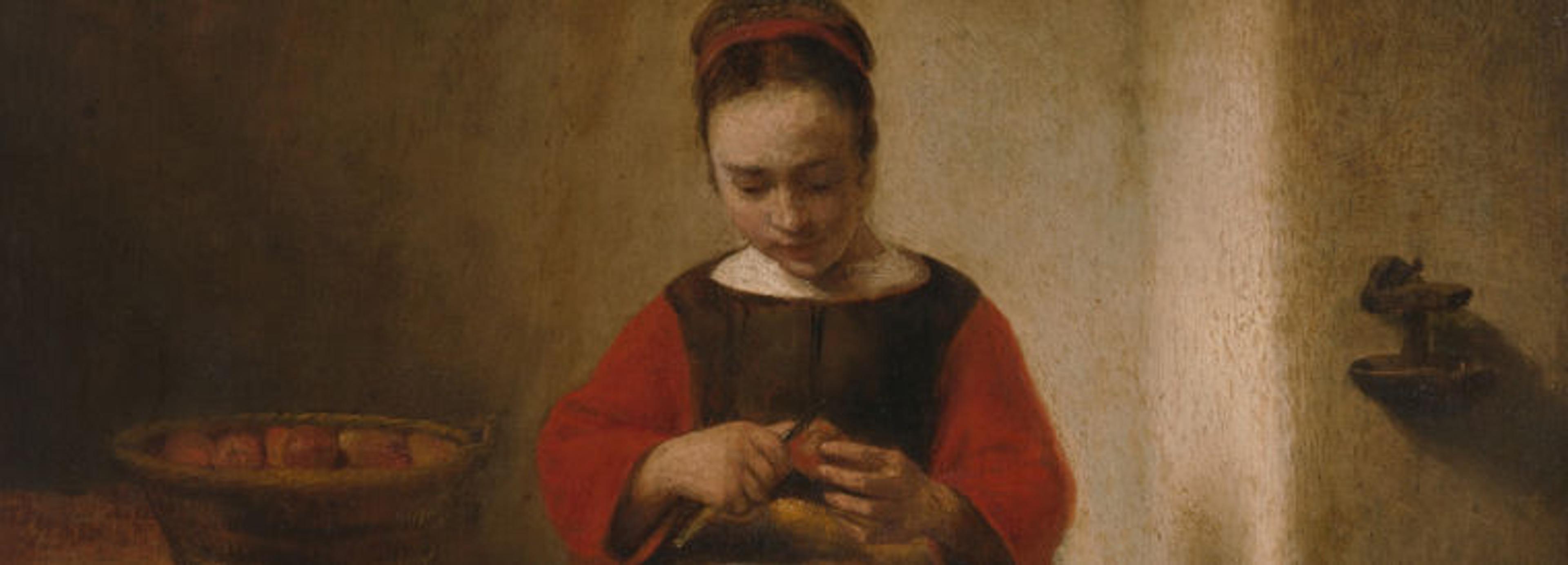

5257. Nicolaes Maes, Young Woman Peeling Apples
NARRATOR: Here, the light shines on an image of virtue: a young girl performing a humble task. In his chosen subject, Nicolaes Maes followed his teacher Rembrandt, who made frequent sketches of the women in his household performing ordinary tasks.
GAVIN FINNEY: They are painting real life, and in so many of these pictures, you can see real people going about their business. Nothing’s perfect. You know, there's dirt on the floor. They have an amazing eye for domestic detail. And they paint working men and working women.
NARRATOR: For cinematographer Gavin Finney, one of the first things he notices about this painting is the light. He tracks its source by following the artist’s trail of clues.
GAVIN FINNEY: If you look at the shadow that the girl is throwing onto the wall, which is quite low down, and the shadow that the wooden candleholder on the wall is throwing, they give you the angle of the window. All the light is coming from a small window quite high up, to the viewer’s left; her right. And that would imply that she’s in the basement or low down in the house, probably in a kitchen or in a cellar.
NARRATOR: Indeed, this painting is arguably as much a portrait of light as of the young girl. Like his peer, Vermeer, and his onetime teacher, Rembrandt, Maes manipulated the light for a desired effect.
GAVIN FINNEY: It seemed to be the point where artists finally got how light behaves realistically in a room. And how it bounces around. It’s not just flat, they weren’t just painting an object. When they rendered the lighting on the faces of the characters, or on the tables, on the walls, the way they did it so correctly—that’s part of what makes the painting come to life and look completely real.
NARRATOR: Finney was the Cinematographer of the BBC drama, The Miniaturist, set in Amsterdam in the 1680s. Paintings from that era were an invaluable resource in his research and preparation.
GAVIN FINNEY: Absolutely my first point of call is the art of the time, because that gives you access to firsthand witnesses; people who were there. And very much for me, the kind of lighting they would have seen.
At his death in 1679, the Dutch painter Jan van de Cappelle left behind a collection of 135 drawings by Rembrandt depicting vrouwenleven, or "lives of women." This term encapsulates one of the major themes of seventeenth-century Dutch art: the everyday activities of women observed while keeping house, getting dressed, or caring for children. This section moves up the social ladder of the Dutch Republic, from Rembrandt's housekeeper to Gerard ter Borch's beautifully dressed younger sister, to explore how Dutch artists depicted this novel subject matter.
Selected Artworks
Press the down key to skip to the last item.
Behind Closed Doors

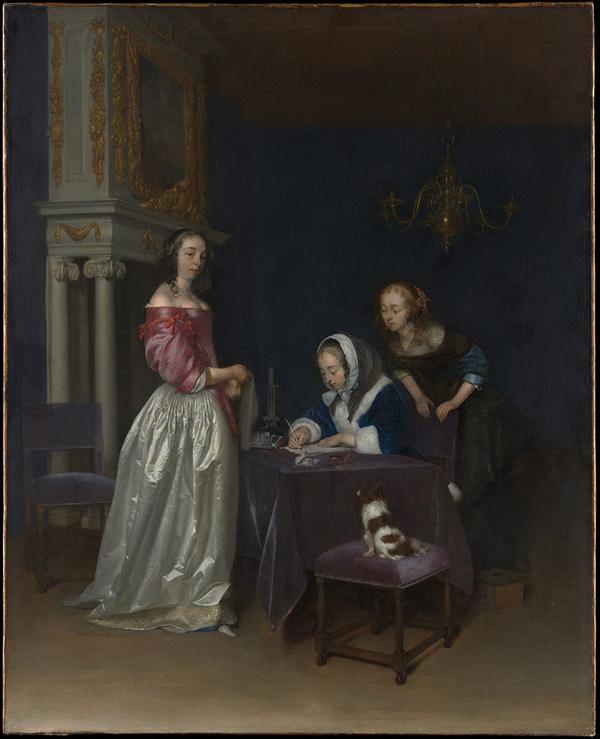
5258. Gerard ter Borch the Younger, Curiosity
NARRATOR: This painting is unusual for its era in that it comes with a trove of primary source documentation. The artist’s half-sister, Gesina, who frequently modeled for his paintings, extensively documented her family life in albums. She preserved every detail down to the name of the dog we see on the cushion. His name is Acteon, a figure from Greek mythology notorious for spying on a bathing goddess. Gesina herself was a poet and an artist.
ADAM EAKER: Observing the social life of this very precocious and talented teenage girl seems to have inspired Ter Borch to create a whole new type of imagery based on scenes of young women writing letters, making music, engaging in flirtation. Almost always dressed in this gorgeous satin that Ter Borch was able to paint better than anyone ever has in the history of art.
NARRATOR: The luscious fabric of the skirts, the gilded fireplace, the plush upholstery, and the high ceiling—all these convey an environment of wealth and privilege. The scene is also charged with something else: being off-limits.
ADAM EAKER: Ter Borch’s paintings really tantalize us by showing the behavior of wealthy women when they believe themselves to be unobserved. This is a scene with erotic overtones. One theory is that the beautiful young woman standing on the left has received a love letter, and has asked her more matronly friend to write a response. There's a story going on here, words are being exchanged that we don’t have access to, and that makes them all the more tantalizing to us.
NARRATOR: Ter Borch’s interest in letter writing alludes to another Dutch achievement: increased literacy, especially among women, well beyond that of their European contemporaries.
ADAM EAKER: Ter Borch uses letter writing and reading as a way to gesture toward the interior life. That is something that Ter Borch passed on to his acquaintance, Johannes Vermeer.
Playlist
The second half of the seventeenth century witnessed major political changes in the Dutch Republic that profoundly affected painting. The peaceful period following the Treaty of Münster in 1648, which ended eighty years of war with Spain, brought wealth to Dutch merchants, fueling their emulation of aristocratic manners and mores. Amorous pursuits and the civilized leisure of the well-to-do became the subject of so-called high-life genre paintings that broke with the coarse and rowdy humor of earlier scenes of everyday life. Gerard ter Borch and Pieter de Hooch pioneered this new form of domestic tableau, whose greatest interpreter would be Vermeer.
Selected Artworks
Press the down key to skip to the last item.
